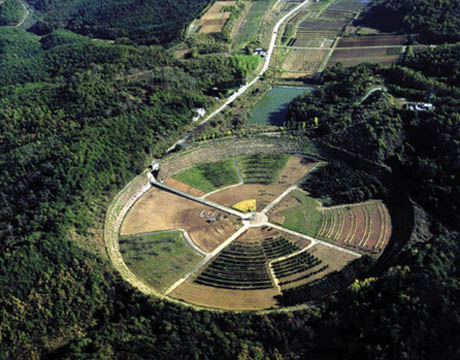
The first public showing of an ‘atomic garden’ took place on March 4, 1961 at the Home and Flower Show in Cleveland, Ohio – (Photo: Frank Scherschel for LIFE Magazine)
The ‘atomic gardening fad’ was part of the ‘Atoms For Peace‘ program – it occurred during the late 50s to the mid-60s. Citizen gardeners, were encouraged to compete with one another in the field of radiation-induced mutagenesis – using irradiated seeds for plants and crops in order to mutate the offspring to make them bigger, more colorful, more resistant to disease and parasites, or to enhance fitness in stressful environmental conditions, such as drought, frost, or poor soils.

Dr. Speas’ Atomic Seed Advert, Chicago Daily Tribune (Graphic via LSF Magazine)
In 1960 dentist-turned-entrepreneur, Clarence J. Speas, founded Oak Ridge Atom Industries, Inc. to sell ‘atomic’ products. Speas, via Oak Ridge, became a major player in the citizen ‘atomic gardening fad’ – to encourage interest, Oak Ridge sponsored a contest for the ‘most unusual plant’ with a prize of $3,000 and agreed to ‘purchase or pay royalties on new varieties deemed to have commercial value.’
This atomic age fad has pretty much faded from history and is usually only referred to in relation to contemporary arguments that surround the use of GMOs by major corporate players like Monsanto. Supporters for the use of GMOs argue that genetic modification of plants and crops is a part of agricultural history for thousands of years – the ‘atomic garden fad’ is an example of how state, corporate, and citizen cooperation can go a long way in viable research through understanding and acceptance of this fact. Those more suspicious of corporate GMO research and implementation of genetically modified plants and crops point out that the ‘atomic garden fad’ was a rare moment of open and shared information between science and the citizen – today’s genetic-modification programs are sheltered from discussion by copyright claims and intellectual property privacy.
Nanotechnology researcher and gardening enthusiast, Paige Johnson, hopes to shed some new light on this mid-century fad. From her research so far she notes that very little information is available about the results related to the citizen gardening. It’s possible that the government may have some research data but it is not easily found. An interesting 2011 interview is posted at the Pruned website here.
It’s interesting to note that while the atomic backyard gardening fad pretty much faded from public attention in the mid-60s, no one is quite sure how many irradiated seeds are still in circulation, or if and how many smaller crops are offspring from generations of genetically modified parents. Also, large scale radiation breeding never actually stopped and is now experiencing a renaissance due to the introduction of ‘new methods that speed up the identification of mutants.’ Below is a photo of the world’s largest ‘gamma garden’ located in Hitachiohmiya, Japan. It has an ‘88.8 Terabecquerel Cobalt-60 source, ringed by a 3,608-foot radius Gamma field, and a 28-foot high shield dike around the perimeter.’

Aerial view of the Institute of Radiation Breeding, Hitachiohmiya, Japan (Photo via Edible Geography)
Info and Photographic Resources:
Life Science Foundation
Edible Geography
Pruned
Thank you very much for this post. It was really a great read.
LikeLike
I have an original stock certificate from
Oak Ridge Atom Industries, 1965 10 shares
Is there any interest in it from museums, collectors or others?
LikeLike
Hi Steve,
Pratt Library has a good article: Evaluating Old Stock Certificates. It gives a good run-down on how to research in scripophily.
A pretty good site to check-out is Scripophily.com. The site is hosted by, RM Smythe Old Company Stock Research. I did a check for Oak Ridge Atom Industries, 1965 – there weren’t any listings, but you can get a good idea regarding list prices of other certificates at the link.
There’s a contact page – perhaps you can get some info regarding your certificate there.
Good luck – you have a great little piece of history…that certificate. There are auction houses that host regular Ephemera sales – but the above would be a good place to start. You should have a knowledge abut the certificate before dealing with some of he auction houses.
LikeLike